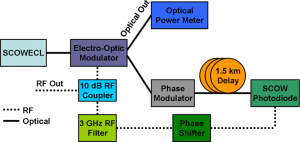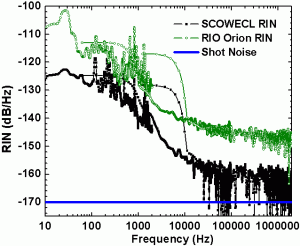Watt-class Optoelectronic Oscillators
- Category: Circuits & Systems, Optics & Photonics
- Tags: Rajeev Ram, William Loh
We are investigating the performance of low-noise, high-power optoelectronic oscillators (OEO) using all slab-coupled optical waveguide (SCOW) components. The optoelectronic oscillator (OEO) demonstrates the capability to generate a pristine tone through down-conversion of a modulated optical carrier into the microwave regime [1] [2] . The two primary advantages for using an optical carrier are low loss (high quality factor (Q)) and large bandwidth (50+ GHz modulation and detection). Other notable advantages of the OEO are its light weight, immunity to electromagnetic interference, and ability to generate both optical and microwave clock outputs. A schematic diagram of the SCOW based-OEO structure is shown in Figure 1. The phase noise performance of an OEO depends largely on the relative intensity noise (RIN) properties of the laser source. Figure 2 compares the SCOW external cavity laser (SCOWECL) [3] to a commercial external cavity semiconductor laser (RIO Orion). The SCOWECL RIN is 10-15 dB lower than the RIO Orion RIN.
High performance optoelectronic oscillators are important as low-noise sources for driving low noise modelocked lasers and as stable local oscillators (LO) for RADAR and communication applications. In modelocked lasers, the noise of the RF oscillator directly transfers to the laser through jitter present during modulation of the optical pulse. In RADAR, the reflected signal after the Doppler shift must overcome the phase noise of the master oscillator reflected off background clutter. Finally, in global positioning system (GPS) applications, the master oscillator’s stability is essential during triangulation of the receiver position. Clock phase noise results in range errors that limit the accuracy of the computed receiver position. In addition to requiring high performance, all of these applications can benefit from a low-size, -weight, and -power compact master oscillator. This is especially true during flight as SWaP becomes critically important for airborne systems compared to ground-based systems.
- Figure 1: SCOW-based optoelectronic oscillator schematic comprising a SCOW external cavity laser (SCOWECL), an electro-optic intensity modulator, a phase modulator, an optical fiber delay, a SCOW photodiode, an RF phase shifter, a 3-GHz RF filter with 1.5-MHz bandwidth, and a 10-dB RF directional coupler.
- Figure 2: Low-frequency SCOWECL and RIO Orion RIN. The RIN was measured in 3 separate intervals 10 Hz – 2 kHz (resolution bandwidth (B) = 10 Hz), 10 Hz – 100 kHz (B = 1 kHz), and 10 Hz – 2 MHz (B = 10 kHz). The regions of divergence occur due to integration close to DC within the resolution bandwidth of each measurement.
- X. S. Yao and L. Maleki, “Optoelectronic microwave oscillator,” J. Opt. Soc. Am. B, vol. 13, pp. 1725-1735, 1996. [↩]
- D. Eliyahu and L. Maleki, “Low phase noise and spurious level in multi-loop opto-electronic oscillators,” in Proc. IEEE International Frequency Control Symposium, 2003, pp. 405-410. [↩]
- W. Loh, F. J. O’Donnell, J. J. Plant, M. A. Brattain, L. J. Missaggia, and P. W. Juodawlkis, “Packaged, high-power, narrow-linewidth slab-coupled optical waveguide external cavity laser (SCOWECL),” accepted for publication in IEEE Photon. Technol. Lett., 2011. [↩]

